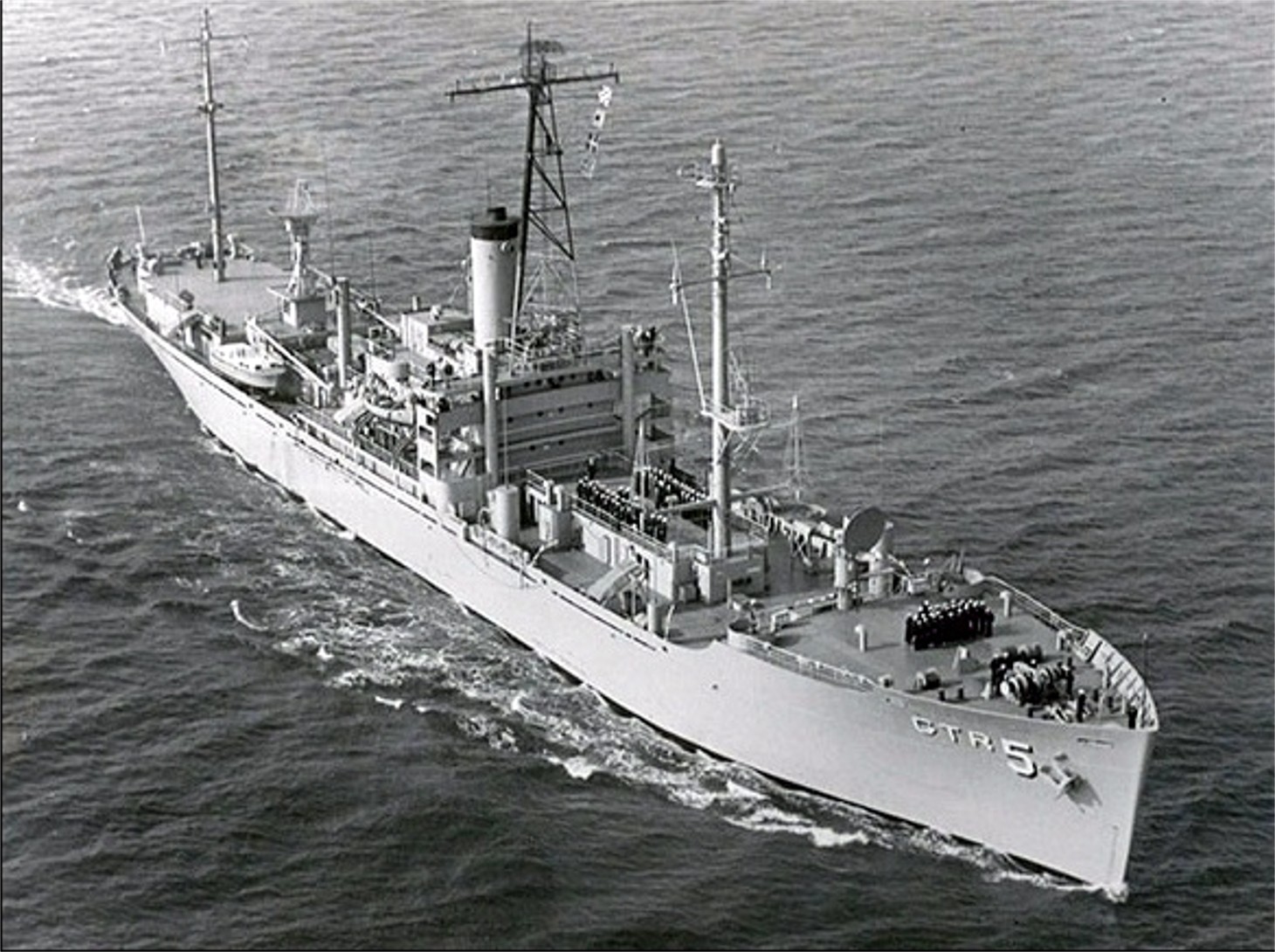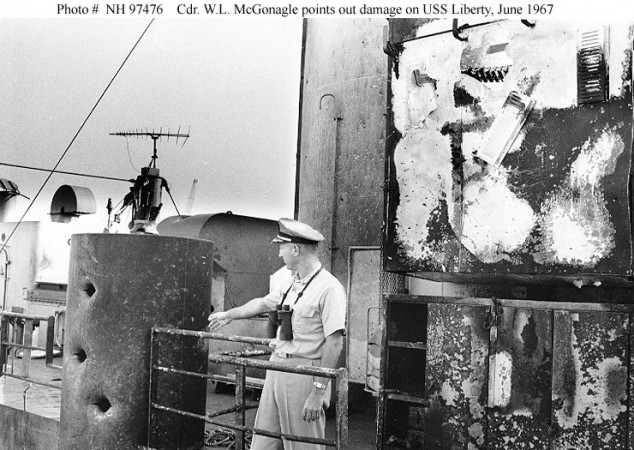
Rated: 4.5 / 5
Currently an entry for this doesn’t exist on IMDB, which is saying a lot considering Europa: The Last Battle has an entry on that site (a less-professionally-made documentary that I’ve begun to find to be more flawed and misinformed the more I look into it, though it does still contain enough valid information to warrant another perspective regarding Nazi Germany and WWII; in other words, Sacrificing Liberty is better). Hopefully that will change at some point. I don’t recall who got word of this 4-part docu-series to me, someone on some social media site with some post mentioning it (I think it was on gab or something). But in any case, I had heard about the incident regarding the attack on the U.S.S. Liberty (which took place June 8, 1967), and only really knew that Israel did the attack, and that a torpedo hit the ship, some 20-30 U.S. crewman died, and there was an attempted cover-up. To this day, not many know about it, or even why. This documentary seeks to inform viewers about that incident.

Honestly, I wasn’t expecting this to be that great. Documentaries that aren’t very well known, especially those that aren’t listed on IMDB, they tend to be of poor quality. And just as bad, they tend to be so preachy about a (plausible) conspiracy theory, on a more radical level than your average Christian movie, that it would put off the majority of viewers, with the only audience remaining being those who pretty much already know about this stuff. So color me shocked and surprised that this documentary is quite well-made, and only dips into the more extreme conspiracy stuff for the last 10-15 minutes of the last episode, at a point where it’s earned.
It gets points for authenticity for interviewing a respectable portion of those who survived the U.S.S. Liberty attack. Soldiers who were actually there, on that ship, from that time period. And, oh thank Christ, it doesn’t get too flashy with how things are portrayed. It’s primarily composed of these guys talking and retelling their experience, how it still haunts them today, and uses some stills, archival footage; and the occasional recreational video/image that is used very sparingly, with attempts to make it look like it was video from the late 60s (primarily for immersion). It’s not like those modern History Channel documentaries made for people with ADHD that overuses both footage and budget on dramatic quick-cut re-enactments. It’s more grounded in its style.
There are two examples that come to mind showcasing this re-enactment style is this moment. The first is when an Israeli helicopter hovers near the topside floor of the ship, and this gunner aims, then sort of holsters his gun, and laughs while flipping the bird. A re-enactment of one of the sailors stating that he want topside, saw this chopper lower itself there, and the Israeli on it aimed at him, and all he could think to do at that moment was laugh and flip the Israeli off. It apparently amused the Israeli enough to where he decided not to open fire and just return the courtesy, before the chopper flew off. The way it’s shot, you could tell it was super-imposed and a fake, but they use enough film grain and lines and artificial deterioration to make it appear more legit than it is. But it’s not to fool anyone that this is archival footage or anything, just for immersion.

The second example is a bit simpler. Primarily uses a photo with some super-imposed still-images, showcasing what this section of the ship’s interior looked like after the attack. When the crew had to go in to begin the cleanup process. Obviously there are sections with body parts scattered everywhere, with a sickening smell. But it got atmospheric and haunting (it creeped me out a bit) when mentioning how this sailor climbed down a ladder, turned around, and used his lamp to see his way around. He mentioned how the place was unrecognizable from the torpedo attack, with walls, doors, equipment mangled. But then he nearly jumped out of his skin when he saw a figure hanging off in the distance. Some body that had washed up to the ceiling, and had stuck there this whole time after they had dry-docked and the water receded. They used a combination of still images, and a lighting technique no different than what you would see in a motion-comic, to visualize this. Cheap, but effective.
Aside from moments like that and some archival footage (they even got footage from the planes doing the attack, and the moment when the torpedo hit the ship), it’s mostly just each sailor/soldier talking to the camera. The filmmakers keep it simple, with very little fancy editing tricks (those are mostly saved for the last 10 minutes of part 4).
So for those who don’t know, you’re probably wondering what this attack is all about? Well, part 1 (Unfriendly Fire) pretty much states the whole incident from the sailor’s point of view. Their ship was an intelligence-gathering ship (top of the line), with very few defensive capabilities (a few torpedoes, and 4 heavy machine guns bolted topside), primarily used to monitor radio frequencies and communication from wherever they were in-range at. Initially positioned on the south-east African coast, they were suddenly ordered to an area off the coast of Egypt’s Gaza Strip, at a time when the Six Day War was about to occur. The Six Day War started on June 5, 1967. The U.S.S. Liberty arrived at its destination on June 7, while being shadowed by a Russian ship a portion of the way to its destination. Hours before the attack, several Israeli spy planes flew over the ship frequently, getting details of the ship.
Then the attack occurs. It starts with several unmarked planes firing upon the Liberty, even dropping napalm onto it. They took out 5 of the six communication dishes/antennas. After enough time passed with that happening, a few small ships, marked with the star of David (thus Israeli ships), began firing on them, and launched 5 torpedoes at the Liberty. One of them hit (taking out the communications room), and by some miracle all the others missed. After more time had passed with the ships and helicopters (all marked with the star of David) firing upon the Liberty, they left, and the attack ended. The entire attack lasted for over two hours. Out of the 294 U.S. sailors that were on board, 34 died, 174 were wounded. The Liberty did manage to put out an SOS which was received, but no help came, not until the day after the attack. It gave me some 13 Hours: Secret Soldiers of Benghazi vibes at that point.

The next two episodes (Perfectly Executed Military Operation, Jigsaw Puzzle), mostly cover the trauma experienced in the aftermath. How the medical facilities were, how messed up the injured were, eventually getting an escort to dry-dock, the clean-up process, how they were all told to keep their mouths shut and tell no one about this, the shellshock experienced on the journey home, etc. The first three parts of the documentary stick with firsthand accounts from the survivors, men of different ranks and security clearances.
But the third episode does end on a note that made me do a double-take. An implication that raised the stakes when a hint is given as to why this had happened (one of the survivors theorizes early on that the Israelis probably wanted to sink the Liberty, make it look like the Egyptians did it, and thus give the U.S. cause to get involved in the Six Day War similar to how they got involved in WWII against Germany, similar to the Gulf of Tonkin incident for Vietnam that also happened under LBJ’s watch, similar to how they got sucked into war with the Middle East ever since 9/11). That another group of ships some 200 miles off where where the Liberty was had launched fighter planes armed with nukes ready to bomb Cairo, Egypt. At that point I was like, “Wait… what!?”

Episode 4 is when the perspective primarily changes from that of the soldiers to that of writers who had researched the incident and even published a book or article regarding the whole thing. They do state that this is primarily a hypothesis, as it can’t be definitively proven, but so far it’s the only one that makes the most sense and is the most plausible explanation as to what had happened. It wasn’t just that Israel wanted to sink the Liberty to get the U.S. to join them in the fight against the Arab States. It was also that Lyndon B. Johnson, and Robert MacNamara (who I’ve come to hate the more I learned about them, even before seeing this documentary) were in on the whole thing. It’s alleged they had the U.S.S. Liberty ordered to the Gaza Strip coast with the full intention of using it as a sacrificial lamb for Israel so that the U.S. could get involved in the war. That way they would receive financial benefits from Israel who would fund LBJ’s administration (more finances for the Vietnam War being one reason). The fact that LBJ’s cabinet had clear Zionist influences with Zionist/Israeli figures as a part of the cabinet, whether in a director position or just an influential one, lends more credit to this hypothesis. But once the entire plan backfired (and it would’ve gotten worse, considering the Russians got wind of this plan, and were threatening to bomb Israel in retaliation if Egypt was nuked, thus instigating a WWIII nuclear holocaust), they were in Israel’s pocket at that point. Because now Israel had something major to blackmail LBJ on. Honestly, I seriously doubt this was the only historical incident Zionists were involved with when it came to major historical incidents swept under the rug; the documentary basically states this was the incident that put the U.S. government in Israel’s pocket, and I’m not so sure I agree, though it certainly did put it in deeper if nothing else.
In any case, I was shocked to see this documentary go so bluntly in this direction of how Zionist influence in the U.S. is what’s causing much of this fucked up stuff to happen. Even to the point where it points out the Zionist influence upon more recent major political figures, from Nancy Pelosi, to Chuck Schumer, to Donald Trump, to Joe Biden. Guess the documentary wanted to make itself that relevant, though this could make it more dated than it should be in a few years. And as much as I loved that such a professionally made documentary actual goes this far at pointing this stuff out, I argue it got too fancy and too blunt about it. But I guess it’s necessary in order to showcase why we’re not going to see any justice done for this incident (among other incidents in the past, and likely in the present, let alone the future). Best we can do is acquire this knowledge, and spread it around, while laws are being put into place that make it more and more illegal to criticize Israel and/or Zionists.

It’s a depressing note, and a depressing (yet tense) documentary, but it comes highly recommended. It can be purchased here, on this official site (where I purchased my DVD copy):
https://www.sacrificingliberty.com/




Just wanted to take a minute to thank you for the excellent review of Sacrificing Liberty.
You may be interested in knowing that I tried to link the url of your article on Facebook but they wouldn’t allow it – undoubtedly no surprise to you.
So I copied it to PDF, uploaded it to the LVA’s server and posted it to Facebook.
Click to access Sacrificing%20Liberty%20%282020%29%20documentary%20review%20_%20The%20Anomalous%20Host.pdf
Joe Meadors
USS Liberty Survivor
Director of Operations, USS Liberty Veterans Association
Email: joe@ussliberty.com
Twitter: @usslibertyvets
LikeLiked by 1 person
Thank you.
Heheh, yeah, you’re not the first one to try linking one of my posts to Facebook and get the same outcome. But kudos for the workaround.
I salute you sir.
LikeLike
Thank you for the write up. I appreciate the thought out comprehensive review.
LikeLiked by 1 person
How can I purchase this film
LikeLike
Try clicking on the link at the bottom of the review (just above the DVD images).
LikeLike
I got it ordered thank you
LikeLiked by 1 person